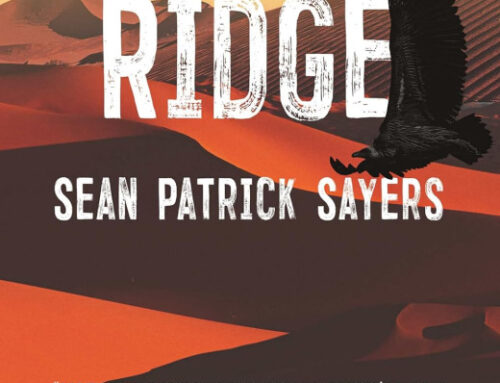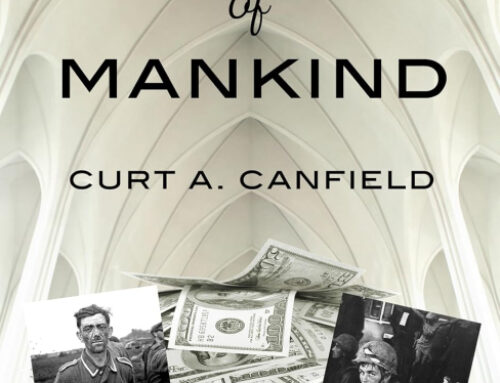Well, it didn’t take long to get a submission. Brian Spaeth has gamely submitted his self-published book for a Design Review. I’ve attached his PDF including the front cover and first 58 pages so if you’d like to comment on the design you can download the sample by simply clicking the cover, or by using this link.
In his email, Brian says: “Disclosure: The typo on the cover is intentional. Bonus points if you can figure out what the front cover is of. All graphics and layout were done by me. Thanks – this is a great idea on your part and I look forward to your analysis!”
Design Review—Cover
Well, Brian, you’re right. I can’t figure out what the front cover illustration is. I don’t think that’s necessarily a benefit to the book.
What the cover does right:
- Title is large and easy to read, important for online listings
- Typography is neat and tidy, and obviously done with care
- Use of gradients and strong colors adds a sense of mystery
Covers of books have a lot of work to do, since they are the “face” your book presents to the world. At the same time, they are like a small billboard that has to communicate vital information quickly and economically. What this cover doesn’t get right:
- Although the copyright pages says that this is a work of fiction, the author has called it an “important reading book.” I haven’t run into this wording before, and I bet other book buyers haven’t either
- The illustration, which upon examination looks like a bit of comic book art, is somewhat pixellated and rough. But more to the point, the illustration adds nothing to the communication with the reader. What exactly is the point of a purposefully obscure illustration?
- Whether the typo in the misspelling of Foreword (spelled here “Forward”) is intentional or not, it will look like a mistake—and a bad one—to any browser.
- The title itself is problematic, since it’s pretty unclear what a “prelude” is in this context.
Although Brian worked hard on this cover, I’m afraid it fails at the basic communication it should be doing with prospective readers. Other than “airplane” there’s virtually no information about the book on the cover.
Design Review—Interior
Here is a sample spread from the book.
Book designers try hard to “get out of the way” of the author, but when you are the author AND the designer, it’s twice as hard to get our of your own way.
The big problem with Brian’s interior is the “watermark” he’s placed on every page. The large “PTSA” in ITC Machine, even though it’s screened back. Screens like this will print much darker at the printer, and the interruption to the reading experience is severe.
Here’s what the interior does right:
- Uses a serviceable serif typeface, which helps readability (looks like Palatino)
- Margins are good, type area lays well on the page
- Overall look of the page is airy, inviting reading.
Where the interior falls down:
- Use of the “watermark” is both irritating and distracting to the reader
- Many mechanical problems. For instance, note that some pages are completely missing folios, and en dashes are used instead of em dashes, spaces around dashes should be eliminated
- Bullets in list are “floating” away from content
- Basic layout is more “memo-style” since paragraphs have no indents and extra space is added between them. Books typically have indented paragraphs and no space between paragraphs. This is just what people expect in a book
- Although not strictly necessary in a novel, running heads might have held the pages together better.
I want to thank Brian for providing his book first off the bat. I look forward to your comments, and to seeing more self-published books for review.
If you’re interested in getting a design review for your book, add a link and a comment in the forum Submit Your Book for a Design Review.
Get an Editorial Review | Get Amazon Sales & Reviews | Get Edited | Get Beta Readers | Enter the SPR Book Awards | Other Marketing Services
























Ooops – in fairness to everyone, that watermark is only on the free sample version that I make available for download on the site. Neither the print nor the ebook versions have this. Sorry about that.
The rest of your critiques are spot-on.
The things you note were also – for the most part – done intentionally. This includes the cover art. You get through the book and it all pays off. I guess it’s performance art writing or something. lol
(The one thing I cop to complete cluelessness on the en v em dashes – it’s probably something like what I just did in this sentence?)
Thanks for taking the look – this is a great feature on the site.
Hey, Brian, thanks for being a willing participant. I hope others will take advantage of it too.
This IS a great addition to the site. What an idea!
P.S. I’d be interested to know if you’re also interested in doing something like a website critique.
Kristen, Thanks! I’m really more of a “print” guy, so I’m not sure what I could say about websites. I tend to like the very readable, with a clear bias toward great typography.
I immediately saw the cover as a spoof on blockbuster movie posters (though a failed one? because it’s too subtle), and that the misspellings and awkward wording are an intentional joke. I’d assume, as a casual observer, that the book is about movie producers or someone like that in the film industry, and that these characters are comically dumb, so it’s a humorous novel.
That’s just my two second gut reading of the cover. I have no idea what the book is about or what the author truly wanted to convey.
Oh the image on the cover just looks like a sky light on a rooftop. Even if that’s not what it is, that’s what it looks like and I never wondered about it, so if it was supposed to be evocative it may have failed.
Just to jump back in, yeah I did wonder if Joel maybe didn’t pick up that the book is a comedy and the title is intentionally stupid with a dash of ridiculously unfit pretension.
In any case, I made a title/cover of a book that would intrigue me and make me want to pick it up, and beyond that really didn’t think about it.
If you read the book, you realize what the over is, then smack your head for not seeing it and appreciate the joke, especially when you see the “Cover Photo by” credit.
btw the BACK cover is also in that download, which might give you some more perspective. Shane you are definitely in the right direction with some of the content.
Shane, Brian,
Yes, it didn’t escape me that the book was tongue-in-cheek, and the various fictions around the “forward” were amusing. My review was done with that in mind. The book still has to work and although it’s amusing, confusing the reader might not always be the best way to go about that.
But it’s Brian’s book, and he has every right to put it out exactly how he wants to. I hope he keeps going and getting better with each project.
I read a review of this book a while back, and I think even the first chapter or two, somewhere, so I thought I’d chime in that I thought it was one of the more perfect design examples I’ve encountered. I get the niggle about the ambiguous cover picture, but I put the book itself in the same category as I regard Zoolander (which I hope will be read for the high praise it is); it’s not just tongue-in-cheek but outright satire that, like all the best satire, never explains itself, remaining perfectly and completely in character. A little like “Borat: Cultural Learnings of America for Make Glorious Benefit Glorious Nation of Kazakhstan,” and I hope that the fact that I just put this book in the same category as Ben Stiller and Sacha Baron-Cohen doesn’t go unnoticed. I think that’s a difficult trick to pull off (too many who might otherwise decide they want to explain and share in the joke. It’s an understandable temptation, but one which should be avoided, as I think this book and author have).
I mean, how can you not love “Brad Radby’s Brad Radby: A Filmography”?
I will agree about the cover illustration, though. If only because, given that the tagline (“This May, Everything Goes Boom!” ZOMG HA!) is right there above the title, it should probably be a bit more movie poster-esque. Then again, given chapter 2’s authorial intrusion (I love meta ftw!), I have a feeling it pays off big at some point, and that it’s a fair sacrifice. When your book is called “prelude to a SUPER AIRPLANE” and the typography design whispers what it doesn’t shout at you so you hear it as voiced by Moviefone man, your image may be a little beside the point.